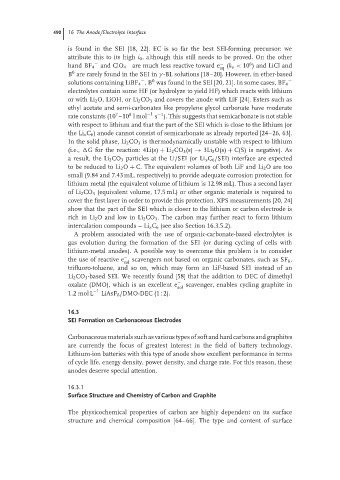Page 517 - Handbook of Battery Materials
P. 517
490 16 The Anode/Electrolyte Interface
is found in the SEI [18, 22]. EC is so far the best SEI-forming precursor: we
attribute this to its high i 0 , although this still needs to be proved. On the other
−
6
−
hand BF 4 and ClO 4 are much less reactive toward e − (k e < 10 ) and LiCl and
aq
0
B are rarely found in the SEI in γ -BL solutions [18–20]. However, in ether-based
− 0 −
solutions containing LiBF 4 ,B was found in the SEI [20, 21]. In some cases, BF 4
electrolytes contain some HF (or hydrolyze to yield HF) which reacts with lithium
or with Li 2 O, LiOH, or Li 2 CO 3 and covers the anode with LiF [24]. Esters such as
ethyl acetate and semi-carbonates like propylene glycol carbonate have moderate
8
7
−1
rate constants (10 –10 l mol −1 s ). This suggests that semicarbonate is not stable
with respect to lithium and that the part of the SEI which is close to the lithium (or
the Li x C 6 ) anode cannot consist of semicarbonate as already reported [24–26, 63].
In the solid phase, Li 2 CO 3 is thermodynamically unstable with respect to lithium
(i.e., G for the reaction: 4Li(s) + Li 2 CO 3 (s) → 3Li 2 O(s) + C(S) is negative). As
a result, the Li 2 CO 3 particles at the Li/SEI (or Li x C 6 /SEI) interface are expected
to be reduced to Li 2 O + C. The equivalent volumes of both LiF and Li 2 O are too
small (9.84 and 7.43 mL, respectively) to provide adequate corrosion protection for
lithium metal (the equivalent volume of lithium is 12.98 mL). Thus a second layer
of Li 2 CO 3 (equivalent volume, 17.5 mL) or other organic materials is required to
cover the first layer in order to provide this protection. XPS measurements [20, 24]
show that the part of the SEI which is closer to the lithium or carbon electrode is
rich in Li 2 O and low in Li 2 CO 3 . The carbon may further react to form lithium
intercalation compounds – Li x C 6 (see also Section 16.3.5.2).
A problem associated with the use of organic-carbonate-based electrolytes is
gas evolution during the formation of the SEI (or during cycling of cells with
lithium-metal anodes). A possible way to overcome this problem is to consider
the use of reactive e − scavengers not based on organic carbonates, such as SF 6 ,
sol
trifluoro-toluene, and so on, which may form an LiF-based SEI instead of an
Li 2 CO 3 -based SEI. We recently found [58] that the addition to DEC of dimethyl
oxalate (DMO), which is an excellent e − scavenger, enables cycling graphite in
sol
−1
1.2mol L LiAsF 6 /DMO-DEC (1 : 2).
16.3
SEI Formation on Carbonaceous Electrodes
Carbonaceous materials such as various types of soft and hard carbons and graphites
are currently the focus of greatest interest in the field of battery technology.
Lithium-ion batteries with this type of anode show excellent performance in terms
of cycle life, energy density, power density, and charge rate. For this reason, these
anodes deserve special attention.
16.3.1
Surface Structure and Chemistry of Carbon and Graphite
The physicochemical properties of carbon are highly dependent on its surface
structure and chemical composition [64–66]. The type and content of surface

